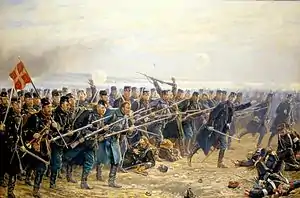Battle of Dybbøl
The Battle of Dybbøl (Danish: Slaget ved Dybbøl; German: Erstürmung der Düppeler Schanzen) was the key battle of the Second Schleswig War, fought between Denmark and Prussia. The battle was fought on the morning of 18 April 1864, following a siege that began on 7 April. Denmark suffered a severe defeat which ultimately decided the outcome of the war.[4][5][6]
| Battle of Dybbøl | |||||||
|---|---|---|---|---|---|---|---|
| Part of the Second Schleswig War | |||||||
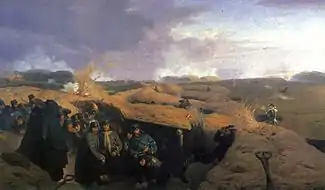
| |||||||
| |||||||
| Belligerents | |||||||
|
|
| ||||||
| Commanders and leaders | |||||||
|
|
| ||||||
| Strength | |||||||
|
11,000 (first wave) 26,000 (in reserve) 126 guns[1] |
5,000 (at the defences) 6,000 (in reserve) 66 guns 11 mortars[2] 1 ironclad warship [3] | ||||||
| Casualties and losses | |||||||
| 1,201 killed, wounded, or captured |
700 killed 554 wounded 3,534 captured Total: 4,834 | ||||||
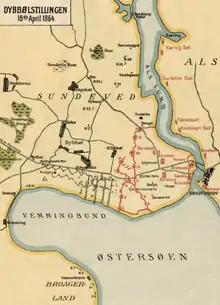
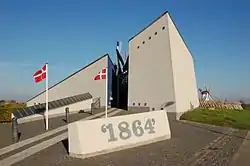
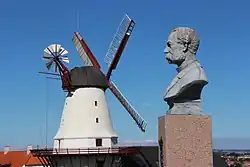
Background
Following the annexation of the Duchy of Schleswig in November 1863 by Danish king Christian IX (who was also the Duke of Schleswig), Prussia and Austria invaded Jutland in January 1864. The defending Danish infantry was equipped with French M1822 percussion muskets converted to Minié rifling and with Tapriffel M1864s. The Prussian army used the Dreyse needle-gun, a breech-loading rifle that could be loaded while the user was lying down. Since the Danes had to load their older muzzle-loading rifles while standing, they were easier targets for the Prussians. [7]
Dybbøl had also been the site of a battlefield in the First Schleswig War. Dybbøl fort lies on a short blunt peninsula that defends against access to the fort by land and featured an enclosed pier for the ferry across the Alssund to Sønderborg on the island of Als.
The Dybbøl position was ill-prepared as a result of too much effort expended on fortifying the Dannevirke. In particular, it lacked safe shelters in the forward line. Technological developments in artillery (particularly long-range rifled guns) had made the geography of the position unsuited for a lengthy defense. The line had too little depth, and across the waters of the southern inlet (forming the southern part of the peninsula) modern guns could subject the main defensive line to raking fire along its length. This meant that not only was the position effectively saturated during the approximately two months of bombardment, but also most of the defending crew had to be withdrawn far behind the line because of attrition by the bombardment and lack of effective shelters, and when the assault was finally initiated, the line was consequently undermanned by tired troops.
However, the Danes did have one major advantage in that they had more or less unchallenged command of the sea and were able to deploy the modern ironclad Rolf Krake to the scene to support ground forces at Dybbøl with shore bombardments from its turret-mounted eight-inch guns. For much of the siege Rolf Krake was used as a mobile heavy seaborne artillery platform and the Prussians were almost helpless to counter it, since they had no naval forces of their own capable of matching the Danish navy, a fact that sapped Prussian morale. [8] For this reason, some Danish generals thought that the Prussians would not dare to mount a frontal attack.
Battle
On the morning of 18 April 1864 at Dybbøl, the Prussians moved into their positions at 2:00. At 10:00 Prussian artillery bombardment stopped and the Prussians charged; shelling from the Rolf Krake did not prove enough to halt them. Thirteen minutes after the charge, the infantry had already seized control of the first line of defense of the redoubts.
A total massacre of the retreating Danish troops was avoided and the Prussian advance halted by a counterattack by the 8th Brigade, until another Prussian attack threw them back; that attack advanced about 1 km and reached Dybbøl Mill. In that counterattack the 8th Brigade lost about half its men, dead or wounded or captured, allowing the remnants of the 1st and 3rd Brigades to escape to the pier opposite Sønderborg. At 13:30 the last resistance collapsed at the bridgehead in front of Sønderborg. After that there was an artillery duel across the Alssund.
During the battle around 3,600 Danes and 1,200 Prussians were either killed, wounded or missing. A Danish official army casualty list at the time said 671 dead; 987 wounded, of whom 473 were captured; 3,131 unwounded captured and/or deserters; total casualties 4,789. The 2nd and 22nd Regiments lost the most. Also, the crew of the Danish naval ship Rolf Krake suffered one dead, 10 wounded.[9] 263 Prussians were killed during the battle.
The Battle of Dybbøl was the first battle monitored by delegates of the Red Cross: Louis Appia (1818-98) and Charles van de Velde (1818-98). Following the battle, the Prussians used the fort area as a starting point to attack Als in June 1864. [10]
Aftermath
While the battle of Dybbøl was a defeat for the Danes, the activities of the Rolf Krake along with other Danish naval actions during the conflict served to highlight the naval weakness of Prussia. In an attempt to remedy this, the Austro-Prussians dispatched a naval squadron to the Baltic, which was intercepted by the Danish Navy at the Battle of Helgoland. [11]
A peace treaty was signed on 30 October 1864 that essentially turned the duchies of Schleswig and Holstein into an "Austro-Prussian condominium, under the joint sovereignty of the two states."[12] The German chancellor, Otto von Bismarck, had taken one of the first steps toward launching the German Empire that would dominate continental Europe until World War I.
Legacy
- See also Second Schleswig War - Consequences.
A ceremony of national commemoration is held at Dybbøl on 18 April each year. Danish soldiers appear in period uniforms. The 140th anniversary (in 2004) was a special event in Denmark. Sociologists still refer to the Battle of Dybbøl when commenting on the relationship between Danes and Germans.
Carl Klinke (1840-1864), a Prussian soldier who is said to have run onto the redoubt carrying explosives and igniting them by the palisades thus killing himself and blowing a hole into the Danish redoubt, was immortalized in a poem written by Theodor Fontane (1819–1898). Composer Johann Gottfried Piefke (1815-1884) dedicated the Düppeler Sturmmarsch to this battle. [13]
On the field of Dybbøl there were formerly national symbols of both warring sides: the Danish Dybbøl Mill and the German Düppel Denkmal. Dybbøl Mill still stands, but the German victory monument was blown up in 1945. The perpetrators were never identified, and this monument has never been rebuilt.[14]
Battle of Dybbøl in popular culture
- 1864 – 2014 Danish television historical drama
- In The Riddle of the Sands (1903, Erskine Childers), Chapter V, the protagonists of the novel visit a monument to the battle near Sonderburg. Character "Davies" speculates "It was a landing in boats, I suppose."
References
- Dybbøl 19. april 1864 Dansk Militærhistorie
- "Archived copy". Archived from the original on 2009-02-28. Retrieved 2010-05-06.CS1 maint: archived copy as title (link)
- "Archived copy". Archived from the original on 2010-10-16. Retrieved 2010-08-22.CS1 maint: archived copy as title (link)
- Jürgen Müller (2006), Der Deutsche Bund 1815–1866 (in German), München: Oldenbourg, p. 46, ISBN 978-3-486-55028-3
- "Schleswigsche Kriege". Gesellschaft für schleswig-holsteinische Geschichte. Archived from the original on 2012-12-08. Retrieved 2013-03-24.
- "Dybbøl, Slaget på" (in Danish). Grænseforeningen. Retrieved 15 July 2015.
- "Arms of the Battle of Dybbøl". myarmoury.com. Retrieved May 1, 2018.
- "Rolf Krake (1863-1907)". Danish Naval History. Retrieved May 1, 2018.
- http://www.hheriksen.dk/images/1864tab.jpg
- "Dr. Louis Appia". The History of the Red Cross Movement. Retrieved May 1, 2018.
- Gert Laursen. "The Battle off Helgoland". Danish Military History. Archived from the original on February 25, 2009. Retrieved May 1, 2018.
- Schulze, Hagen (1998). Germany: A New History. trans. by Deborah Lucas Schneider. Cambridge, Mass.: Harvard University Press. pp. 138–140.
- "Theodor-Fontane-Archivs". fontanearchiv. Archived from the original on May 6, 2018. Retrieved May 1, 2018.
- "Düppeldenkmal". schutzgebiete.de. Retrieved May 1, 2018.
Other sources
- Tom Buk-Swienty (2016) 1864: The Forgotten War That Shaped Modern Europe (Profile Books) ISBN 978-1781252765
- Nick Svendsen (2010) First Schleswig-Holstein War 1848 (Helion and Company) ISBN 978-1906033446
| Wikimedia Commons has media related to Battle of Dybbøl. |
External links
- Battle of Dybbøl (Military History of Denmark)
- Military History of Denmark – Account of the operations of the Ironclad "Rolf Krake" at Dybbøl (in English)
- Map of Battle of Dybbøl (in English)
- Table of Danish army losses at Battle of Dybbøl (in Danish)
- Krigen i 1864 (in Danish)
- Article on the war of 1864 (in Danish)
- AM II, 185 AMS "Düppeler Sturmmarsch" Youtube
- Heeresmusikkorps 2 - Düppeler Schanzenmarsch 2010 Youtube
